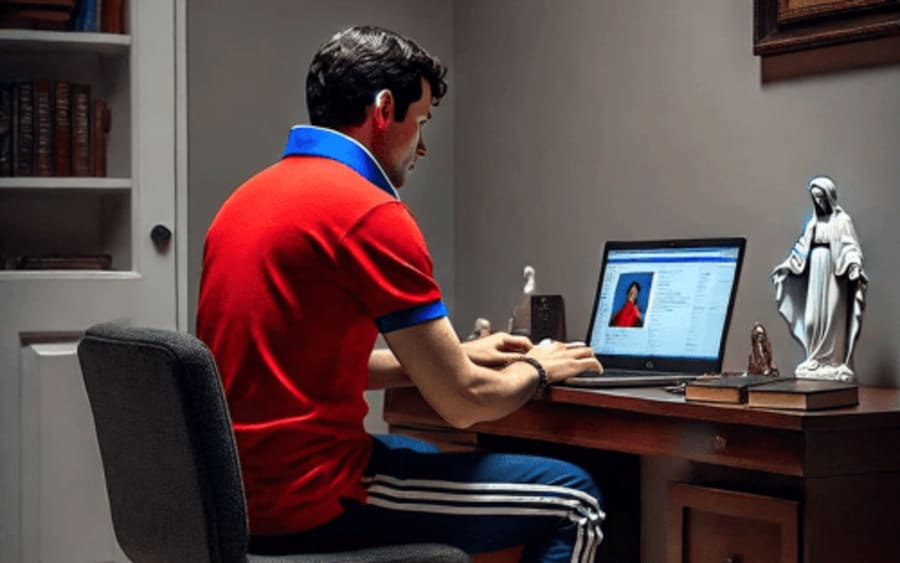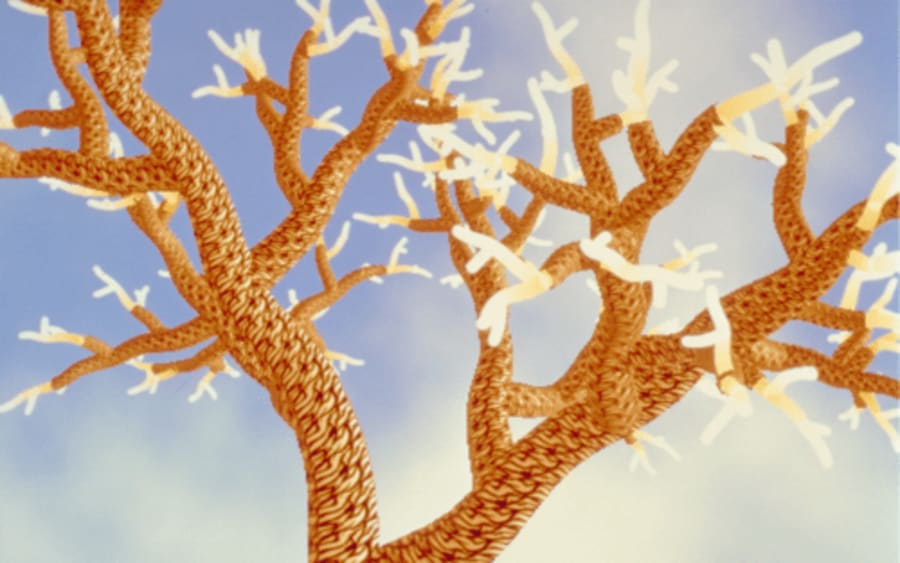「我最早的記憶與寫作有關。 那時我只有七歲,住在大馬士革。 母親希望我能順利拿到小學文憑,所以她告訴我應該把精力放在教科書上,而不是沉溺於文學作品,這樣才能保證學業成績。 但我心想,既然不能讀我喜歡的書,我就自己寫一本,於是我開始動筆創作我的第一部小說。 當時我受到了露意莎.梅.奧爾柯特(Louisa May Alcott)《小婦人》改編電影的啟發,電影中四姐妹之一就成為了小說家。 我另一段青年時期的重要記憶也和另一本書有關,那時我十四歲,讀了賽珍珠(Pearl S. Buck)的《This Proud Heart》 (1938),書中的女主角是一位雕塑家,這也潛移默化地影響了我後來的藝術道路。」
「小時候,我幾乎每天都會在午睡時間做刺繡。 我認為刺繡是所有想要嘗試藝術創作的人的絕佳選擇,它本身就是一種重要的藝術形式。 當時我們的家庭女教師擅長做蝶古巴特(découpage),還教會了我們。 這件事也對我的藝術創作產生了深遠影響,我所有的拼貼藝術作品都源於此。」
「我25歲開始自學繪畫。 由於從未接受過藝術學校的專業教育,我告訴自己,現在開始並不晚,要相信自己的能力。 我全身心地投入其中,日復一日,不分晝夜地學習。 我還閱讀了大量的畫家著作,並參觀了巴黎和倫敦的許多博物館。 」
「我父母在大馬士革的公寓宛如一個地毯博物館。 我父親是個收藏家,地毯不僅鋪滿了地面,還掛在牆壁、扶手椅和沙發上,整個空間都被地毯覆蓋。 這種完美卻又如此抽象的藝術對我產生了決定性的影響。 它的抽象之美在於其樸素無華,沒有繁複的裝飾或多餘的細節,以簡潔明瞭的方式傳達一切。」
「我們生命中的每一步都會留下印記,我們的每一個選擇都在塑造著我們的藝術創作。 我總是留意生活、藝術等方方面面的每一個細節,觀察周圍的一切事物,並拍照記錄下來。 這種生活態度讓我學會了活在當下,全身心地體驗每一個瞬間。 比方說,我小時候學了十年鋼琴,這對我後來的編輯工作大有裨益。 雖然我現在已經不彈琴了,但我知道那些知識和經驗都深藏在我內心深處,助我前行。 這種感覺很難用言語解釋清楚,但我確信它是真實存在的。 萬事萬物都相互交織,彼此碰撞,但往往難以用肉眼察覺。 我們所為之事與所見之景,都意義非凡。」
「維也納對我們家族有著特殊的意義。 我的祖父曾是奧匈帝國駐奧斯曼帝國的翻譯官,在大馬士革的家中接待過哈布斯堡大公,還説明過許多當地的奧地利人,其中不乏名人。 在第一次世界大戰前,由於奧斯曼帝國與奧匈帝國的盟友關係,大馬士革成了奧地利人的聚集地。 我父親在維也納接受教育,然後子承父業。 以前家裡的陽臺和車上都掛著奧地利國旗。 因此,我對維也納有一種親切感,它不僅是一個地理位置,更是我的整個家族歷史的一部分。 我母親的家族也與這座城市有著密切的聯繫,因為她的祖父也是奧地利人。」
「維也納分離派展覽館(Secession in Vienna)歷史悠久,能在此展出我的作品,我感到無比自豪。 儘管這不是一個回顧展,但我仍然納入了一些我最具代表性的雕塑作品。 此外,我還藉此機會創作了一些拼貼藝術,以此表達我對貝多芬的熱愛,並將我的作品與展覽館內特別致敬這位偉大天才的空間緊密相連。 」
「我目前面臨的挑戰是如何堅持自己的道路。 連綿不斷的戰爭和無處不在的悲觀情緒無法激發我的藝術靈感。 我很幸運自己能夠受到青睞,這對我説明很大。 我喜歡為特定的地點創作,它們能帶來新的視角和方向。 每個地方都蘊藏著新的機會,等待著獨特的故事徐徐展開。」
‘One of the turning points in our career was the invitation to show in the Slovenian pavilion at the Venice Biennale in 2001. We were only 24 and, up until that point, we had not done any exhibitions. It was also the first time that Net Art was being shown at the Venice Biennale, so the stakes were very high. We created a computer virus called Biennale.py and we released it on the night of the opening. It quickly spread around the world. In the pavilion, an installation featured two connected computers infecting and disinfecting each other in an endless cycle.
‘Once the virus was released, we immediately lost control. At 7pm, the pavilion opened its doors and all hell broke loose, journalists with recorders, televisions with cameras…We were expecting some interest, but we were completely overwhelmed by the media frenzy that followed. Biennale.py
was not only spreading as a piece of code, but – maybe even faster – it was spreading as a piece of news, the computer virus became a sort of meme. Not everyone hated it though, Harald Szeemann, the curator of the Biennale, called it that year’s most innovative project.
‘That work featured a lot of the elements we’d keep exploring in subsequent years, like Internet culture, circulation, virality, trolling, online-offline relations, etc. It was also a crash course in the artworld at large, outside of our Net Art niche, although we only really started working professionally as artists after we moved to New York in the mid-2000s.
‘We got into AI when it began to handle space and perspective. We started feeding it with photos of some of our previous works from the series “Personal Photographs” [2019–ongoing] – loops of cable tray hosting coils of brightly colored ethernet cable – and it generated lmost-realistic images of sculptures we might potentially have made. After generating the images, we built the actual sculptures, choosing materials, dimensions, and colors by interpreting the choices and mistakes of the AI. In other words, we generated a photographic version of “the work;” then, at a later stage, we worked backwards to create “the original.”
‘Generally, we’re late adopters. We tend to start using a technology only after we’ve seen how people are actually using it, which may be in a very different way from the intentions of its creator. For example, Emily’s Video [2012] is a piece of ours that compiles the reactions of various viewers while watching unknown – yet apparently horrible – footage. It was inspired by the so-called reaction videos that began to proliferate on YouTube in the mid-2000s. Who would have thought that, given the largest free video platform available to humanity, people would start filming themselves while watching others’ videos?
We just finished a new piece called J8~g#I|\;Net. Art{-^s1, which is a sculpture composed of two colored metal circuits connected by ethernet cables, constantly exchanging a single file. What they share is the email revealing the disputed origin of the term “net.art,” which was sent by the artist Alexei Shulgin to the mailing list Nettime on March 18, 1997. We’ve been meaning to make a piece about that email since we first heard the story some 27 years ago: finally, we’ve found the right solution. Talk about late adopters…
‘We live in a permanent state of disbelief, astonishment, and euphoria, induced by everything we see online. Every given minute, there’s a genius teenager in their bedroom producing the most amazing thing: an image, a joke, a video, a meme. Memes are the unconscious of the Internet, they make us think of new forms of fables, or myths, or folk art. We see them as an open window into the subconscious of humanity: observing how they are born and spread can reveal people’s innermost feelings, impulses, anxieties, fears, and desires.
‘As artists, we cannot compete with the Internet’s super-fast, ever-changing flow of images, ideas, and stimuli. There’s no point in trying to re-create that speed, that energy. What we can do is select one thing and isolate it from the rest to produce a moment of reflection on these processes – even if only for a minute.’
西蒙娜.法塔爾由kaufmann repetto藝廊(米蘭及紐約)、Balice Hertling畫廊(巴黎)、Hubert Winter藝廊(維也納)、Karma International藝廊(蘇黎世)和Greene Naftali藝廊(紐約)代理。
「西蒙娜.法塔爾:metaphorS」
維也納分離派展覽館(Secession)
2024年6月21日至9月8日
Patrick Steffen是巴塞爾藝術展的法國編輯,他現駐巴黎。
所有照片由Marion Berrin為巴塞爾藝術展拍攝。
2024年6月24日發佈。


